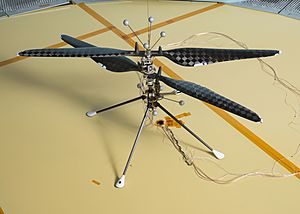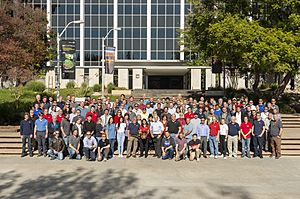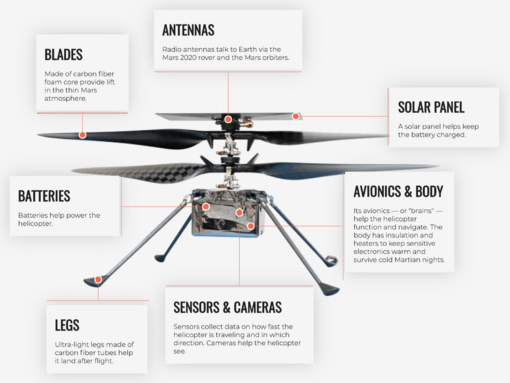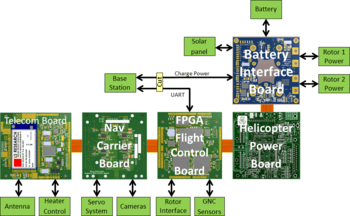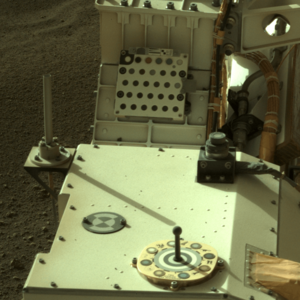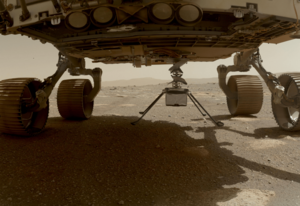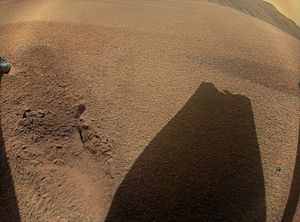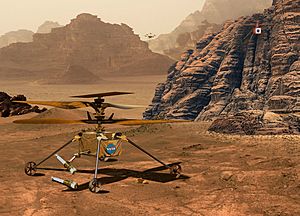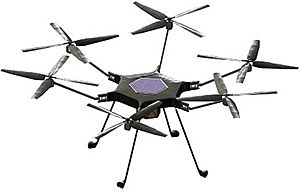Ingenuity (helicopter) facts for kids
Quick facts for kids Ingenuity |
|
|---|---|
| Part of Mars 2020 | |

Ingenuity at Wright Brothers Field on April 6, 2021, its third day of deployment on Mars
|
|
| Type | Extraterrestrial autonomous UAV helicopter |
| Manufacturer | Jet Propulsion Laboratory |
| Technical details | |
| Dimensions | 121 cm × 49 cm × 52 cm (48 in × 19 in × 20 in) |
| Dry mass | 1.8 kilograms (4.0 lb) |
| Power | 6 Solar-charged Sony VTC-4 Li ion batteries; typical engine input power: 350 watt |
| Flight history | |
| First flight | 19 April 2021, 07:34 UTC |
| Last flight | January 18, 2024 |
| Flights | 72 |
| Fate | Retired due to sustained rotor blade damage |
| Instruments | |
|
|
Ingenuity, nicknamed Ginny, was an autonomous helicopter which operated on the planet Mars from 2021 to 2024. It was part of NASA's Mars 2020 mission. The helicopter arrived on the Martian surface attached to the underside of the Perseverance rover. The helicopter was deployed to the surface on April 3, 2021. Both the rover and the helicopter began their missions on Mars at the Octavia E. Butler Landing site near the western rim of the 28 mi (45 km) wide Jezero crater. On April 19, 2021, Ingenuity made the first powered, controlled extraterrestrial flight by any aircraft.Ingenuity had been operating on Mars for 1042 sols (1071 total days; 1 year, 341 days) before retirement on 25 January 2024.
The flights demonstrated the helicopter's ability to fly in the extremely thin atmosphere of Mars, which is only 0.6% as dense as the air on Earth. It proved that flight was possible on other planets without the direct human control that the finite speed of light makes impractical (depending on the positions of the two planets, radio signals take between 5 and 20 minutes to travel between the Earth and Mars). As a result of this delay Ingenuity autonomously performed the maneuvers planned, scripted and transmitted to it by its operators.
The helicopter was intended to perform a 30-sol technology demonstration, making five flights at altitudes ranging from 3–5 m (10–16 ft) for up to 90 seconds each. After a brief demonstration phase to prove its airworthiness, JPL commenced a series of flights designed to show how aerial scouting could aid the exploration of Mars and other worlds. In this operational role Ingenuity scouted areas of interest for the Perseverance rover. The helicopter's performance and resilience in the harsh Martian environment greatly exceeded expectations. The aircraft surpassed its required altitude and flight duration specifications soon after beginning operations on Mars. This allowed Ingenuity to perform far more flights than were initially expected of the aircraft. On January 18, 2024, the helicopter was damaged upon landing during its 72nd flight, and NASA announced its retirement after a much longer life than planned. Ingenuity had flown a total of two hours, eight minutes and 48 seconds in 1,004 days, covering more than 10 miles (16 km).
Ingenuity was designed by NASA's Jet Propulsion Laboratory (JPL) in collaboration with AeroVironment, NASA's Ames Research Center and Langley Research Center. Contributors of key components included Lockheed Martin Space, Qualcomm, and SolAero.
Contents
Development
Concept
The development of the project that would eventually become Ingenuity started in 2012 when JPL director Charles Elachi toured and met with members of the Autonomous Systems Division at JPL. The idea for the project drew on prior concept work in the division. By January 2015, NASA agreed to fund the development of a full-size model, which came to be known as the "risk reduction" vehicle. NASA's JPL and AeroVironment published the conceptual design in 2014 for a scout helicopter to accompany a rover. By mid-2016, $15 million was being requested to continue development of the helicopter. By December 2017, engineering models of the vehicle had been tested in a simulated martian atmosphere and models were undergoing testing in the Arctic, but its inclusion in the mission had not yet been approved or funded.
Mission integration
At the time of the approval of the Mars 2020 program in July 2014, a helicopter flight demonstration was neither scoped nor budgeted.
The United States federal budget, announced in March 2018, provided $23 million for the helicopter for one year, and it was announced on May 11, 2018, that the helicopter could be developed and tested in time to be included in the Mars 2020 mission. The helicopter underwent extensive flight-dynamics and environment testing, and was mounted on the underside of the Perseverance rover in August 2019. NASA spent about $80 million to build Ingenuity and about $5 million to operate the helicopter.
In 2019, preliminary designs of Ingenuity were tested on Earth in simulated Mars atmospheric and gravity conditions. For flight testing, a large vacuum chamber was used to simulate the very low pressure of the atmosphere of Mars – filled with carbon dioxide to approximately 0.60% (about 1⁄160) of standard atmospheric pressure at sea level on Earth – which is roughly equivalent to a helicopter flying at 34,000 m (112,000 ft) altitude in the atmosphere of Earth. In order to simulate the much-reduced gravity field of Mars (38% of Earth's), 62% of Earth's gravity was offset by a line pulling upwards during flight tests. A "wind-wall" consisting of almost 900 computer fans was used to provide wind in the chamber.
In April 2020, the vehicle was named Ingenuity by Vaneeza Rupani, a girl in the 11th grade at Tuscaloosa County High School in Northport, Alabama, who submitted an essay into NASA's "Name the Rover" contest. Known in planning stages as the Mars Helicopter Scout, or simply the Mars Helicopter, the nickname Ginny later entered use in parallel to the parent rover Perseverance being affectionately referred to as Percy. Its full-scale engineering model for testing on Earth was named Earth Copter and, unofficially, Terry.
Ingenuity was designed to be a technology demonstrator by JPL to assess whether such a vehicle could fly safely. Before it was built, launched and landed, scientists and managers expressed hope that helicopters could provide better mapping and guidance that would give future mission controllers more information to help with travel routes, planning, and hazard avoidance. Based on the performance of previous rovers through Curiosity, it was assumed that such aerial scouting might enable future rovers to safely drive up to three times as far per sol. However, the new AutoNav capability of Perseverance significantly reduced this advantage, allowing the rover to cover more than 100 meters per sol.
Development team
The Ingenuity team was comparatively small, with never more than 65 full-time-equivalent employees from JPL. Program workers from AeroVironment, NASA AMES and Langley research centers brought the total to 150. Key personnel include:
- MiMi Aung – Ingenuity Mars Helicopter Project Manager at NASA's Jet Propulsion Laboratory,
- Bob Balaram – Chief Engineer (prior to Nov 2021)
- Timothy Canham – Flight Software Lead and Operations Lead (prior to June 2021)
- Håvard Fjær Grip – GNC Lead and Chief Pilot
- Matt Keennon – AeroVironment Technical Lead
- Ben Pipenberg – AeroVironment Design Lead
- Josh Ravich – Mechanical Engineering Lead
- Teddy Tzanetos – Operations Lead
- Nacer Chahat – Antenna Engineer and Telecom System Engineering
On June 15, 2021, the team behind Ingenuity was named the 2021 winner of the John L. "Jack" Swigert Jr. Award for Space Exploration from the Space Foundation. On April 5, 2022, the National Aeronautic Association awarded Ingenuity and its group in JPL the 2021 Collier Trophy.
Design
Mechanical design
Ingenuity consists of a rectangular fuselage measuring 136 mm × 195 mm × 163 mm (5.4 in × 7.7 in × 6.4 in) suspended below a pair of coaxial counter-rotating rotors measuring 1.21 m (4 ft) in diameter. This assembly is supported by four landing legs of 384 mm (15.1 in) each. It also carries a solar array mounted above the rotors to recharge its batteries. The entire vehicle is 0.49 m (1 ft 7 in) tall.
The lower gravity of Mars (about a third of Earth's) only partially offsets the thinness of the 95% carbon dioxide atmosphere of Mars, making it much harder for an aircraft to generate adequate lift. The planet's atmospheric density is about 1⁄100 that of Earth's at sea level, or about the same as 87,000 ft (27,000 m), an altitude never reached by existing helicopters. This density reduces even more in Martian winters. To keep Ingenuity aloft, its specially shaped blades of enlarged size must rotate between 2400 and 2900 rpm, or about 10 times faster than what is needed on Earth. Each of the helicopter's contra-rotating coaxial rotors are controlled by a separate swashplate that can affect both collective and cyclic pitch. Although it is an aircraft, it was constructed to spacecraft specifications to endure the acceleration and vibrations during launch.
Avionics
Ingenuity relies on different sensor packages grouped in two assemblies. All sensors are commercial off-the-shelf units.
The Upper Sensor Assembly, with associated vibration isolation elements, is mounted on the mast close to the vehicle's center-of-mass to minimize the effects of angular rates and accelerations. It consists of a cellphone-grade Bosch BMI-160 Inertial measurement unit (IMU); and an inclinometer (Murata SCA100T-D02), which is used only on the ground prior to flight to calibrate the IMU accelerometers biases. The Lower Sensor Assembly consists of an altimeter (Garmin LIDAR Lite v3), cameras, and a secondary IMU, all mounted directly on the Electronics Core Module (not on the mast).
Ingenuity uses a 425×165 mm solar panel to recharge its batteries, which are six Sony Li-ion cells with 35–40 Wh (130–140 kJ) of energy capacity (nameplate capacity of 2 Ah). Flight duration is not constrained by the available power, but by the motors heating up 1 °C every second. The helicopter uses a Qualcomm Snapdragon 801 processor with a Linux operating system. Among other functions, it controls the visual navigation algorithm via a velocity estimate derived from terrain features tracked with the navigation camera. The Qualcomm processor is connected to two radiation-resistant flight-control microcontroller units (MCUs) to perform necessary control functions under Mars's conditions.
The telecommunication system consists of two identical radios with monopole antennae for data exchange between the helicopter and rover. The radio link utilizes the low-power Zigbee communication protocols, implemented via 914 MHz SiFlex 02 chipsets mounted in both vehicles. The communication system is designed to relay data at 250 kbit/s over distances of up to 1,000 m (3,300 ft). The antenna on the helicopter's solar panel weighs 4 grams and can communicate equally in all directions.
Cameras and photography
Ingenuity is equipped with two commercial-off-the-shelf (COTS) cameras: a high-resolution Return to Earth (RTE) camera and a lower resolution navigation (NAV) camera. The RTE camera consists of the Sony IMX 214, a rolling shutter, 4208 × 3120-pixel resolution color sensor, fitted with a Bayer color filter array and an O-film optics module. The NAV camera consists of an Omnivision OV7251, a 640 × 480 black and white global shutter sensor, mounted to a Sunny optics module.
Unlike Perseverance, Ingenuity does not have a special stereo camera for taking twin photos for 3D pictures simultaneously. However, the helicopter can make such images by taking duplicate color photos of the same terrain while hovering in slightly offset positions, as in flight 11, or by taking an offset picture on the return leg of a roundtrip flight, as in flight 12.
While the RTE color camera is not necessary for flights (as in flights 7 and 8), the NAV camera operates continuously throughout each flight, with the captured images used for visual odometry to determine the aircraft's position and motion during flight. Due to limitations on the transmission rate between the aircraft, the rover, and Earth, only a limited number of images can be saved from each flight. Images to save for transmission are defined by the flight plan prior to each flight, and the remaining images from the NAV camera are discarded after use.
As of December 16, 2021, 2091 black-and-white images from the navigation camera and 104 color images from the terrain camera (RTE) have been published.
Flight software
The helicopter uses autonomous control during its flights, which are telerobotically planned and scripted by operators at Jet Propulsion Laboratory (JPL). It communicates with the Perseverance rover directly before and after each landing.
The flight control and navigation software on the Ingenuity can be updated remotely, which has been used to correct software bugs and add new capabilities as the helicopter continues to operate beyond its original mission. Prior to flight 34, the software was updated to avoid hazards during landing and to correct a navigation error when traveling over uneven terrain. This update became necessary as the helicopter traveled away from the relatively flat terrain of the original landing site, and towards more varied and hazardous terrain.
Specifications
| Rotor speed | 2400–2700 rpm |
| Blade tip speed | <0.7 Mach |
| Originally planned operational time | 1 to 5 flights within 30 sols |
| Flight time | Up to 167 seconds per flight |
| Maximum range, flight | 704 m (2,310 ft) |
| Maximum range, radio | 1,000 m (3,300 ft) |
| Maximum altitude | 12 m (39 ft) |
| Maximum possible speed |
|
| Battery capacity | 35–40 Wh (130–140 kJ) |
Operational history
Primary mission
Perseverance dropped the debris shield protecting Ingenuity on March 21, 2021, and the helicopter deployed from the underside of the rover to the Martian surface on April 3, 2021. That day both cameras of the helicopter were tested taking their first black-and-white and color photographs of the floor of Jezero Crater in the shadow of the rover. After deployment, the rover drove approximately 100 m (330 ft) away from the drone to allow a safe flying zone.
Ingenuity's rotor blades were successfully unlocked on April 8, 2021, (mission sol 48), and the helicopter performed a low-speed rotor spin test at 50 rpm.
A high-speed spin test was attempted on April 9, but failed due to the expiration of a watchdog timer, a software measure to protect the helicopter from incorrect operation in unforeseen conditions. On April 12, JPL said it identified a software fix to correct the problem. To save time, however, JPL decided to use a workaround procedure, which managers said had an 85% chance of succeeding and would be "the least disruptive" to the helicopter.
On April 16, 2021, Ingenuity successfully passed the full-speed 2400 rpm rotor spin test while remaining on the surface. Three days later, April 19, JPL flew the helicopter for the first time. The watchdog timer problem occurred again when the fourth flight was attempted. The team rescheduled the flight, which succeeded on April 30. On June 25, JPL said it had uploaded a software update the previous week to permanently fix the watchdog problem, and that a rotor spin test and the eighth flight confirmed that the update worked.
Each flight was planned for altitudes ranging 3–5 m (10–16 ft) above the ground, though Ingenuity soon exceeded that planned height. The first flight was a hover at an altitude of 3 m (9.8 ft), lasting about 40 seconds and including taking a picture of the rover. The first flight succeeded, and subsequent flights were increasingly ambitious as allotted time for operating the helicopter dwindled. JPL said the mission might even stop before the 30-day period ended, in the likely event that the helicopter crashed, an outcome which did not occur. In up to 90 seconds per flight, Ingenuity could travel as far as 50 m (160 ft) downrange and then back to the starting area, though that goal was also soon exceeded with the fourth flight.
After the successful first three flights, the objective was changed from technology demonstration to operational demonstration. Ingenuity flew through a transitional phase of two flights, 4 and 5, before transitioning to its operations demonstration phase. By November 2023, the principal mission priorities were to:
- Avoid significant interference with, or delay of, rover operations
- Maintain vehicle health and safety
- Perform scouting for tactical planning and science assessment
- Perform experiments to inform mission and vehicle design for future Mars rotorcraft, or collect data for discretionary science
Operations Demo Phase
Just prior to the final demonstration flight, on April 30, 2021, NASA allocated funding to continue the operation of Ingenuity for an "operational demonstration phase" to explore using a helicopter as supplementary reconnaissance for ground assets like Perseverance. Funding for Ingenuity was regularly renewed on a monthly basis.
Starting with the 6th flight, the mission goal shifted towards supporting the rover science mission by mapping and scouting the terrain. While Ingenuity would do more to help Perseverance, the rover would pay less attention to the helicopter and stop taking pictures of it in flight. JPL managers said the photo procedure took an "enormous" amount of time, slowing the project's main mission of looking for signs of ancient life. On 30 April 2021, the fourth flight successfully captured numerous color photos and explored the surface with its black-and-white navigation camera. On May 7, Ingenuity successfully flew to a new landing site.
After 12 flights by September 2021, the mission was extended indefinitely. After 21 flights by March 2022, NASA said it would continue flying Ingenuity until at least the coming September. The area of the helicopter's next goal was more rugged than the relatively flat terrain it flew over in its first year of operation. The ancient fan-shaped river delta has jagged cliffs, angled surfaces and projecting boulders. Ingenuity helped the mission team decide which route Perseverance should take to the top of the delta and aided it in analyzing potential science targets. Software updates eliminated the helicopter's 50-foot altitude limit, allowed it to change speed in flight, and improved its understanding of terrain texture below it. NASA associate administrator Thomas Zurbuchen said less than a year earlier "we didn't even know if powered, controlled flight of an aircraft at Mars was possible." He said the transformation in understanding what the aircraft can do is "one of the most historic in the annals of air and space exploration."
The Ingenuity team planned to fly the helicopter every two to three weeks during its indefinitely extended mission. The helicopter's longer-than-expected flying career lasted into a seasonal change on Mars, when the atmospheric density at its location became even lower. The flight team prepared by commanding Ingenuity to ground test a faster rotor blade rotation, needed for sufficient lift. JPL said the higher planned flight speed of 2700 rpm would pose new risks, including vibration, power consumption and aerodynamic drag if the blade tips approach the speed of sound. The test speed was 2800 rpm, giving a margin for increase if the intended flight speed of 2700 is not enough. Ingenuity faced another challenge to remain functional during the Martian winter and solar conjunction, when Mars moves behind the Sun, blocking communications with Earth and forcing the rover and helicopter to halt operations. The shutdown happened in mid-October 2021, for which preparations started in mid-September. The helicopter remained stationary at its location 175 meters (575 feet) away from Perseverance and communicated its status weekly to the rover for health checks. JPL intended to continue flying Ingenuity since it survived solar conjunction. NASA leadership has stated that extending the mission will increase the project's expenses, but that they believe the cost to be worthwhile for the information learned.
The start time of a flight was chosen depending on temperature management of the batteries, which needed to warm up after the night. During Martian summer lower air density imposed a higher load on the motors, so flights were shifted from noon (LMST 12:30) to morning (LMST 9:30) and limited to 130 seconds to not overheat the motors.
On May 3 and 4, 2022, for the first time in the mission, the helicopter unexpectedly failed to communicate with the rover, following the 28th flight on April 29. JPL determined that Ingenuity's rechargeable batteries suffered a power drop or insufficient battery state-of-charge (SOC) while going into the night, most likely because of a seasonal increase in atmospheric dust reducing sunshine on its solar panel and due to lower temperatures as winter approached. When the battery pack's state of charge dropped below a lower limit, the helicopter's field-programmable gate array (FPGA) powered down, resetting the mission clock, which lost sync with the base station on the rover. Contact was re-established on May 5. Controllers decided to turn off the helicopter's heaters at night to conserve power, accepting the risk of exposing components to nighttime's extreme cold. This daily state-of-charge deficit is likely to persist for the duration of Martian winter (at least until September/October).
In a June 6, 2022, update, JPL reported Ingenuity's inclination sensor had stopped working. Its purpose was to determine the helicopter's orientation at the start of each flight. Mission controllers developed a workaround using the craft's inertial measurement unit (IMU) to provide equivalent data to the onboard navigation computer.
In January 2023, the helicopter began to have enough solar power to avoid overnight brownouts and FPGA resets due to the start of Martian spring. This means the helicopter will be able to fly more frequently and over longer distances.
In March 2023, the helicopter made frequent flights to deal with limited radio range in the rough terrain of the Jezero delta. In the narrow canyons of the river delta, the helicopter needed to stay ahead of the rover, rather than entering a "keep out" zone and passing it, which JPL considered potentially hazardous.
Mission controllers have lost contact with Ingenuity after a few flights, when the helicopter was not in the line of sight with Perseverance, preventing radio communication with the rover, which relays flight data between the helicopter and Earth. After the 49th flight on April 2, 2023, JPL lost contact with Ingenuity for six days, until Perseverance drove to a spot where communication was re-established. JPL had no contact with the helicopter for 63 days after flight 52 on April 26, 2023. Mission controllers had intentionally flown Ingenuity out of radio range, expecting to regain communication in a few days. Perseverance controllers, however, changed their exploration plans and drove further out of range, and then had difficulty collecting rock samples, adding another delay before finally driving toward the helicopter and re-establishing contact on June 28. Communication with Ingenuity was lost again at the end of the 72nd flight on January 18, 2024. JPL regained contact on January 20.
Imagery obtained in the wake of flight 72 showed that one or more rotor blades were damaged during landing, preventing further operations. On January 25, 2024, NASA Administrator Bill Nelson announced the end of the Ingenuity mission, and a follow-up press conference was hosted later that day. Following this, the Ingenuity team is scheduled to perform tests on the helicopter systems and download the remaining data onboard.
Follow-on missions and future work and conceptions
There are currently no plans to send Curiosity/Perseverance-class scientific laboratories to Mars, and funding for Martian projects is frozen to the level necessary to complete the Mars sample-return campaign.
Sample Return Helicopter
The idea of future Martian helicopters has been proposed. In March 2022, AeroVironment engineers, who previously created Ingenuity, presented the concept of a new helicopter with a payload of 280 g. A 90 g small manipulator arm with a two-fingered gripper and a self-propelled landing gear make it possible to use vehicles of this type instead of a fetch rover to select sample tubes cases with samples collected by Perseverance. At a briefing on September 15, 2022, NASA Planetary Science Division Director Laurie Gleizes confirmed her intention to use two of these helicopters.
The choice of Ingenuity as the prototype for the intended pair of assembler helicopters was based on the impressive safety margin built into it by AeroVironment designers. In principle, even the limit of 100 landings for the high-wear shock absorbers of the chassis is sufficient to transfer all 43 sleeves. Multiple small payloads can be carried by these types of helicopters, deployed and re-deployed to various locations, to perform a variety of distributed and networked operations.
Inertial navigation was one of the main challenges on Mars for the Ingenuity. The helicopter needs to show the ability to accurately follow the track it has already "mapped" on previously collected NAV frame sets and land at the takeoff point. In a future sample return mission, each cartridge case would require a pair of flights ending at the point of departure. Landing accuracy was an assigned task of Ingenuity's 31st flight. The very thin atmosphere of Mars does not allow repeating the maneuvers and landing techniques of terrestrial helicopters.
Mars Science Helicopter
Data collected by Ingenuity are intended to support the development of future helicopters capable of carrying larger payloads. The Mars Science Helicopter task is the next evolutionary step for Martian rotorcraft at JPL. The key focus is to develop the technology needed to deploy science payloads (0.5kg - 2kg) on rotorcraft platforms at the surface of Mars. MSH will inherit many of the technologies created by the Mars Helicopter Technology Demonstrator (MHTD) baselined for Mars 2020, and extend capabilities in order to enable a new class of mesoscale planetary access across Mars.
Designing and proving how science payloads can be deployed, recovered, integrated, and operated on a dynamically and computationally representative rotorcraft will be critical in expanding a new frontier for Martian scientific exploration.
The focus will include:
- Rotorcraft configurations capable of carrying and deploying science payloads
- Forecasting technological advancements in avionics, batteries, power systems, and navigation algorithms.
- Earthbound demonstration testbed for evaluating avionics and payload integrations along with MHTD inherited FSW, C&DH, and eventual autonomous science mission execution.
MAGGIE
Mars Aerial and Ground Intelligent Explorer (MAGGIE) is a compact fixed wing aircraft proposed during 2024 NIAC selections with ultra-high productivity efficiency powered by solar energy to fly in the Martian atmosphere with vertical take-off/landing (VTOL) capability, which is enabled by advanced deflected slipstream technology with CoFlow Jet (CFJ). The cruise Mach number of MAGGIE is 0.25 with a cruise lift coefficient CL of 3.5, nearly an order of magnitude higher than conventional subsonic aircraft to overcome the low density of the Martian atmosphere. The ultra-high cruise CL with CL/CDc of 9 is made possible by CFJ that overcomes the low Reynolds number effect on Mars. The range of MAGGIE for a fully charged battery per 7.6 sol is 179 km at altitude of 1,000 m. The total range of MAGGIE per Martian year is 16,048 km. The representative mission for MAGGIE presented would conduct three atmospheric and geophysical investigations, all supporting different timescales of the Dynamic Mars science theme. These include a study of the origin and timing of the Martian core dynamo from the weak magnetic fields found in the large impact basins, a regional investigation of the source of methane signals detected by the Tunable Laser Spectrometer on the Mars Science Laboratory in Gale crater, and mapping of subsurface water ice at high resolution in the mid-latitudes where it has been observed from orbit. The conceptual MAGGIE system study indicates that the concept appears to be feasible, but need to be further investigated, designed, and verified under Martian atmospheric conditions in Phase I. MAGGIE would be able to perform the first global-scale atmospheric mission at Mars and revolutionize our capability of exploring almost the entirety of the Martian surface. It is the first concept to enable ongoing exploration of this region of Mars and would provide a substantial leap in capability for NASA's exploration of the Red Planet. The attractiveness of airborne missions on Mars has been amply demonstrated by the Ingenuity helicopter. MAGGIE would be similarly engaging to the public, both in its audacity, and in the variety of environments it could explore, study, and image. The technology would also enhance VTOL aircraft technology on Earth and other planets.
Tributes to the Wright brothers
NASA and JPL officials described the first Mars Ingenuity helicopter flight as their "Wright Brothers moment", by analogy to the first successful powered airplane flight on Earth. A small piece of the wing cloth from the Wright brothers' 1903 Wright Flyer is attached to a cable underneath Ingenuity's solar panel. In 1969, Apollo 11's Neil Armstrong carried a similar Wright Flyer artifact to the Moon in the Lunar Module Eagle.
NASA named Ingenuity's first take-off and landing airstrip Wright Brothers Field, which the UN agency ICAO gave an airport code of JZRO for Jezero Crater, and the drone itself a type designator of IGY, call-sign INGENUITY.
See also
 In Spanish: Mars Helicopter Ingenuity para niños
In Spanish: Mars Helicopter Ingenuity para niños
- ARES
- Atmosphere of Mars – Less than 1% of the Earth's atmosphere pressure and primarily composed of carbon dioxide (95% CO2), molecular nitrogen (2.8%, N2) and argon (2% Ar)
- Coaxial rotors
- Dragonfly – Robotic rotorcraft mission to Saturn's moon Titan, planned launch in 2027
- Exploration of Mars
- List of artificial objects on Mars
- List of firsts in aviation
- Sky-Sailor
- Solar panels on spacecraft
- Vega – The USSR space program that included the first atmospheric balloon flight on Venus, in 1985
- Collier Trophy – Presented to the Ingenuity team in 2022 for "the greatest achievement in aeronautics or astronautics in America during the preceding year"


